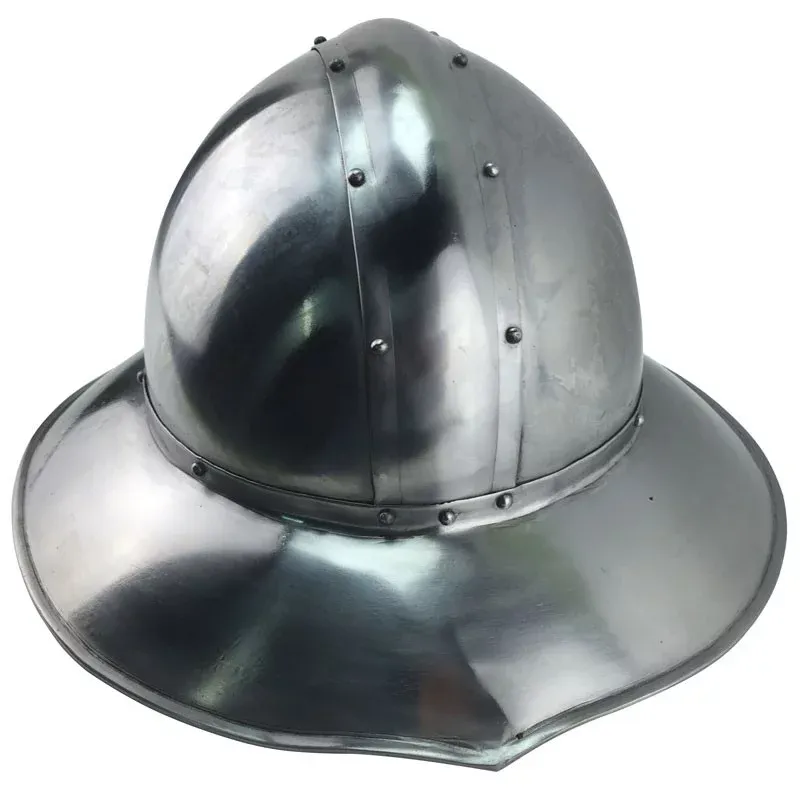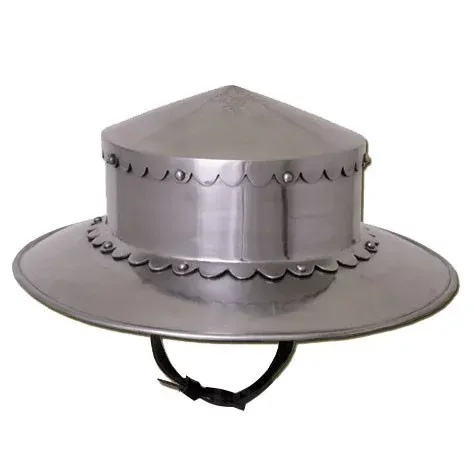What is a Kettle?
The Kettle hat, also known as the war helmet or chapel de fer, is an iconic piece of medieval armor, notable for its design that resembles a cooking pot or cauldron, hence its name in English. This helmet was made of iron or steel and was characterized by its wide brim, providing effective protection. Throughout the centuries, the Kettle hat has been used by various types of fighters, becoming an essential element of war equipment in the Middle Ages.

Main characteristics of the Kettle hat
The design of the Kettle hat is simple yet extraordinarily functional, contributing to its popularity during the Middle Ages. Some of its outstanding features include:
- Cone-shaped or rounded dome: protects the top of the head.
- Wide brim: provides additional protection for the face, neck, and shoulders.
- Robust construction: made from a single piece of metal or by joining plates.
- Facial opening: ensures good visibility and breathing.
- Option for additional protection: allows for the addition of a mesh coif to protect the neck and sides of the head.
History and use
The Kettle hat emerged in Europe around the 12th century and was extensively used until the 16th century. It found common ground among various groups of fighters, such as:
- Infantry: its low cost and ease of production made it ideal.
- Archers and crossbowmen: did not obstruct vision during combat.
- Light cavalry: balanced protection and mobility.
Its effectiveness lay in the balance between protection and comfort, allowing soldiers to see and breathe without restrictions, while also protecting them from arrows and downward strikes.
Advantages of the Kettle hat
This medieval helmet offered various advantages over other designs of the time:
- Effective protection: especially against blows and projectiles from above.
- Visibility and ventilation: the wearer could see and breathe freely.
- Lightweight and comfortable: suitable for prolonged use.
- Simple production: easy to manufacture in large quantities.
- Versatility: suitable for different types of fighters and combat situations.
Variations and evolution
Over time, the design of the Kettle hat evolved, adapting to new needs:
- Movable visors: added for greater facial protection.
- Extensions: for better neck protection and sides of the head.
- Reinforcements and ribs: increased the helmet's durability.
- Chainmail and gorgets: incorporated for added protection.
By the 16th century, more elaborate variations such as the Spanish morion and the Italian cabasset emerged, but the basic concept of the protective wide brim prevailed.

Legacy and influence
The design of the Kettle hat left a lasting mark on the history of military helmets. In World War I, it was reflected in the creation of the British Brodie helmet and the French Adrian helmet, both drawing on the idea of the protective wide brim. Today, the Kettle hat remains an iconic symbol in historical representations, film, and video games that take us back to the Middle Ages, faithfully representing the common soldier of the time.
The Kettle hat not only played a crucial role in the personal defense of medieval soldiers, but its design also influenced future generations of military equipment. It is an example of how a simple and effective solution can withstand centuries of technological evolution and remain relevant in many aspects.
















